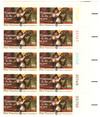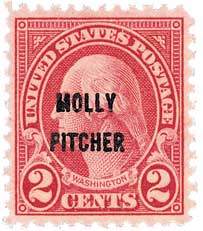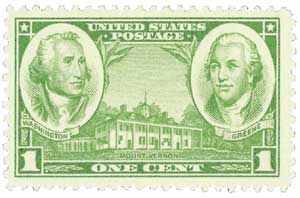
# 1562 PB - 1975 18c Contributors to the Cause: Peter Francisco
1975 18¢ Peter Francisco
Contributors to the Cause Series
City: Greensboro, North Carolina
Quantity: 44,825,000
Battle Of Monmouth
In 1778, the British planned to evacuate their position in Philadelphia and move the majority of their troops to the main base in New York City. On June 18, the troops began their 100-mile march in temperatures over 100 degrees.
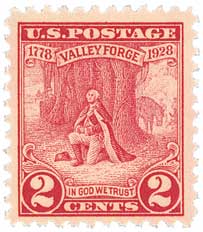
Washington believed the British troops were vulnerable and ordered a 5,000-man attack led by Major General Charles Lee. Lee disagreed with the plan and gave his men poor orders, leading to a disorganized attack on June 28. After several hours of fighting in the extreme heat, Lee’s men retreated.
Meanwhile, Washington was leading his larger army towards the battle when he discovered Lee’s men retreating. He relieved Lee of his command and rallied the troops. Some went on to delay the British pursuit, while the majority moved to the west to prepare for a fight. Once the British reached the American army at Monmouth Courthouse, they fought for an hour until the British line was forced to reform.
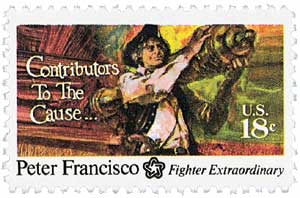
The British attempted several times to attack the Americans from the lower ground but were repeatedly pushed back. Nightfall ended the battle, and the British marched away under the cover of darkness. Lee was court-martialed, leaving New Jersey residents searching for a new hero. Many believed that hero to be Mary Ludwig Hays…
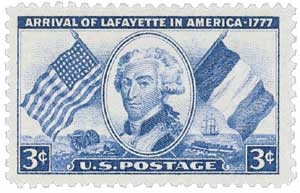
According to legend, Mary Ludwig Hays, the wife of an American artilleryman, brought water pitchers to the field during the Battle of Monmouth. The men took to calling her “Molly Pitcher” as she brought spring water to swab the cannons and quench the men’s thirst. When her husband was hurt and unable to man his cannon, Mary reportedly took his place and later tended to his wounds.
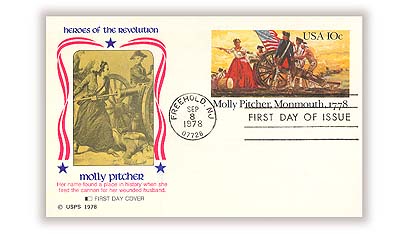
There has been some doubt about whether the Molly Pitcher story was true or not. There were several tales from different battles about women joining in the fight as Mary may have done. Many historians consider the legend of Molly Pitcher to be a combination of these various stories.
As the anniversary of the Battle of Monmouth approached, New Jersey residents requested that a stamp be issued honoring the fabled heroine Molly Pitcher. However, the Post Office Department claimed it had issued its quota of commemoratives and couldn’t issue the stamp they wanted. But New Jersey Congressman Harold G. Hoffman believed that his state deserved a stamp for its role in the Revolution and continued to write letters to the Post Office Department.
Finally, with support from Connecticut Congressman John Q. Tilson, the Department agreed to issue an overprinted stamp, as they had done with the Discovery of Hawaii stamp. While New Jersey residents were happy to have their stamp, collectors and the general public were unimpressed with the stamp’s lack of creativity, not even showing who or what Molly Pitcher was.
The “Molly Pitcher” stamp is an overprint on the regular two-cent value of the 1922-23 series. This overprint and others issued as commemoratives in 1928 caused confusion even in US post offices when they were mistaken for canceled regular issues stamps!
1975 18¢ Peter Francisco
Contributors to the Cause Series
City: Greensboro, North Carolina
Quantity: 44,825,000
Battle Of Monmouth
In 1778, the British planned to evacuate their position in Philadelphia and move the majority of their troops to the main base in New York City. On June 18, the troops began their 100-mile march in temperatures over 100 degrees.

Washington believed the British troops were vulnerable and ordered a 5,000-man attack led by Major General Charles Lee. Lee disagreed with the plan and gave his men poor orders, leading to a disorganized attack on June 28. After several hours of fighting in the extreme heat, Lee’s men retreated.
Meanwhile, Washington was leading his larger army towards the battle when he discovered Lee’s men retreating. He relieved Lee of his command and rallied the troops. Some went on to delay the British pursuit, while the majority moved to the west to prepare for a fight. Once the British reached the American army at Monmouth Courthouse, they fought for an hour until the British line was forced to reform.

The British attempted several times to attack the Americans from the lower ground but were repeatedly pushed back. Nightfall ended the battle, and the British marched away under the cover of darkness. Lee was court-martialed, leaving New Jersey residents searching for a new hero. Many believed that hero to be Mary Ludwig Hays…

According to legend, Mary Ludwig Hays, the wife of an American artilleryman, brought water pitchers to the field during the Battle of Monmouth. The men took to calling her “Molly Pitcher” as she brought spring water to swab the cannons and quench the men’s thirst. When her husband was hurt and unable to man his cannon, Mary reportedly took his place and later tended to his wounds.

There has been some doubt about whether the Molly Pitcher story was true or not. There were several tales from different battles about women joining in the fight as Mary may have done. Many historians consider the legend of Molly Pitcher to be a combination of these various stories.
As the anniversary of the Battle of Monmouth approached, New Jersey residents requested that a stamp be issued honoring the fabled heroine Molly Pitcher. However, the Post Office Department claimed it had issued its quota of commemoratives and couldn’t issue the stamp they wanted. But New Jersey Congressman Harold G. Hoffman believed that his state deserved a stamp for its role in the Revolution and continued to write letters to the Post Office Department.
Finally, with support from Connecticut Congressman John Q. Tilson, the Department agreed to issue an overprinted stamp, as they had done with the Discovery of Hawaii stamp. While New Jersey residents were happy to have their stamp, collectors and the general public were unimpressed with the stamp’s lack of creativity, not even showing who or what Molly Pitcher was.
The “Molly Pitcher” stamp is an overprint on the regular two-cent value of the 1922-23 series. This overprint and others issued as commemoratives in 1928 caused confusion even in US post offices when they were mistaken for canceled regular issues stamps!



